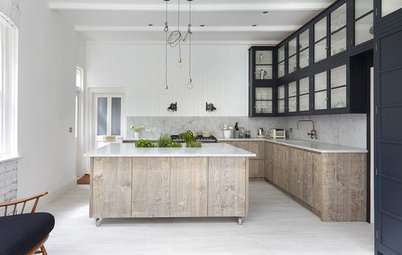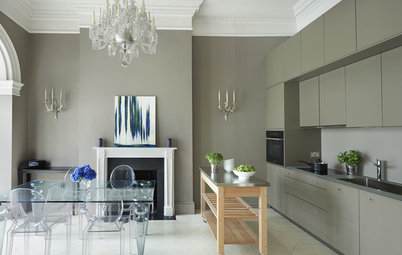Pro Panel: How the Island is Shaping the Kitchens of the Future
Three Danish design experts reveal why the island is the superstar of tomorrow's kitchens
Kitchen islands have been a popular feature for many years now, and they have become the indispensable focal point for socialising in many homes – as much on fast-paced weekdays as on leisurely weekend mornings. Experts from three Danish kitchen design firms, Helle Fyllgraf of JKE Design, Anna Grethe Jørgensen of Kvik Denmark and Jannie Kjær of Multiform, share three reasons why islands are so popular at the moment and discuss what the future holds.
Anna Grethe Jørgensen of Kvik Denmark says kitchen islands offer people a chance to spend time together in their busy everyday lives.
“Twenty years ago, we broke down the walls between kitchens and living rooms in order to bring people together in the kitchen,” she says. “Today, everyday life is busy and sometimes chaotic. More than ever, we need somewhere to be together, and the island often plays an important role in this. It’s where we can gather and concentrate on relationships, relax and talk. It is around the island that everyday life becomes surprising and the weekend magical,” says Jørgensen.
“Twenty years ago, we broke down the walls between kitchens and living rooms in order to bring people together in the kitchen,” she says. “Today, everyday life is busy and sometimes chaotic. More than ever, we need somewhere to be together, and the island often plays an important role in this. It’s where we can gather and concentrate on relationships, relax and talk. It is around the island that everyday life becomes surprising and the weekend magical,” says Jørgensen.
According to Helle Fyllgraf of JKE Design, the social element will become more and more important. “Busy young people and families with children have so many individual activities going on, but it is around the island that they spend time together, talk and enjoy each other’s company. Even if it’s only for a short while, at least they’re together.”
Find a kitchen designer and renovator near you on Houzz to design your dream kitchen
Find a kitchen designer and renovator near you on Houzz to design your dream kitchen
The social aspect also means that the boundary between kitchen and living room is slowly being broken down. “The kitchen now often accommodates an armchair or a sofa, because it needs to be a room people enjoy spending time in,” says Kjær. “The kitchen has become the meeting place of the house, and many visitors never even go beyond it.”
The functional aspect
Yet Fyllgraf points out that functionality is also key to the island’s predominance. “Everyone who has enough space in their kitchen wants an island. It provides more benchtop and storage space, and at the same time it can incorporate features like a sink and a stove. The extra space is especially helpful if you cook a lot,” says Fyllgraf.
Yet Fyllgraf points out that functionality is also key to the island’s predominance. “Everyone who has enough space in their kitchen wants an island. It provides more benchtop and storage space, and at the same time it can incorporate features like a sink and a stove. The extra space is especially helpful if you cook a lot,” says Fyllgraf.
Kjær says that a kitchen island with a sink provides a significant amount of food-preparation space. “We stand at the sink for approximately 90 percent of the time we spend in the kitchen, so it means a lot to have plenty of room on both sides of the sink.”
Here too, the social aspect plays a part. “The island has almost become a ‘dishwashing island’, as we stand by the sink more than by the stove,” says Hornemann. “When the sink is located in the island, you can wash dishes and still face family, friends and guests.”
However, this is not the only recent change in the functionality of kitchen islands. “Now that the appliance industry has come up with new downdraft stoves, you can cook your food out in the middle of the room without having to worry about damaging the ceiling, and without overwhelming the benchtop with a range hood that would take up half the island,” says Kjær.
Here too, the social aspect plays a part. “The island has almost become a ‘dishwashing island’, as we stand by the sink more than by the stove,” says Hornemann. “When the sink is located in the island, you can wash dishes and still face family, friends and guests.”
However, this is not the only recent change in the functionality of kitchen islands. “Now that the appliance industry has come up with new downdraft stoves, you can cook your food out in the middle of the room without having to worry about damaging the ceiling, and without overwhelming the benchtop with a range hood that would take up half the island,” says Kjær.
The aesthetic aspect
Another growing trend sees kitchen islands fulfilling more than just social or functional roles: aesthetics are increasingly important. “In the future, we will see islands being made of different materials than the rest of the kitchen, so they will stand out as a design object, a beautiful icon of furniture design and quality. The kitchen will change character and consist of more free-moving furniture of different materials and designs,” says Hornemann.
Another growing trend sees kitchen islands fulfilling more than just social or functional roles: aesthetics are increasingly important. “In the future, we will see islands being made of different materials than the rest of the kitchen, so they will stand out as a design object, a beautiful icon of furniture design and quality. The kitchen will change character and consist of more free-moving furniture of different materials and designs,” says Hornemann.
“The island is becoming something that stands in the room like a beautiful piece of furniture – no stove or sink, just a big island with a benchtop, which makes sitting around it easier, as you don’t have to worry about getting splashed from the sink or frying pan,” says Kjær.
The future of the island
What does this tell us about the kitchen islands of the future? “The kitchen island will have a new and even more social function. We will see several different versions of the island with more seating and more room for dining,” says Fyllgraf.
What does this tell us about the kitchen islands of the future? “The kitchen island will have a new and even more social function. We will see several different versions of the island with more seating and more room for dining,” says Fyllgraf.
Kjær agrees. “The island will be our social gathering point for years to come. We will, however, see more creative solutions – among other things, the integration of places to eat where you don’t necessarily sit in a row, but across from one other, so you can face one another. This can be done, for example, with a large L-shaped island, which also leaves room for a sink and stove,” says Kjær.
“We still dream about conversation and togetherness in the kitchen,” says Jørgensen. “It’s no longer a physical wall we need to break down; rather, it’s the wall that all our digital devices create. We look forward to helping each other cook at the island, because this is where quality conversation takes place.”
Your turn
How have these insights inspired your future kitchen design plans? Tell us in the Comments below, like this story, save your favourite images, and join the conversation.
More
Are you keen for more Scandinavian design insights? Don’t miss Danish Design Guru Answers: What Makes a Design Classic?
How have these insights inspired your future kitchen design plans? Tell us in the Comments below, like this story, save your favourite images, and join the conversation.
More
Are you keen for more Scandinavian design insights? Don’t miss Danish Design Guru Answers: What Makes a Design Classic?


















As Jannie Kjær of Multiform points out, kitchens have changed a lot over the past decades, and versatile and multi-functional kitchen islands have held a special place in consumers’ hearts.
This is especially true for families with children: kitchen islands are especially popular because they offer a place to get together on busy afternoons and quiet weekend mornings.
“The island gives families with children the opportunity to combine cooking, homework and socialising, the latter being especially valuable,” says Lene Halse Hornemann, designer and owner of Multiform’s Design Centre in Copenhagen. “And for couples whose children have moved away from home, it’s the idea that one person can cook and the other can sit with a glass of wine on a bar stool by the island and enjoy the moment.”